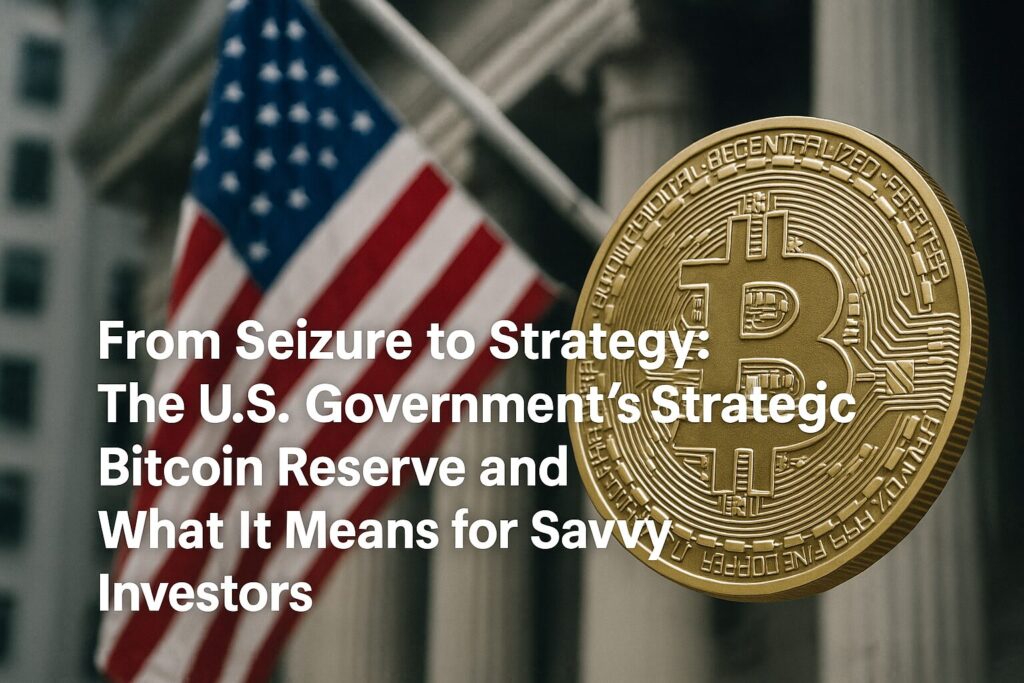
Main Points :
- The U.S. government now holds approximately 200,000 BTC as a Strategic Bitcoin Reserve, sourced from criminal and civil forfeitures.
- An executive order issued in March 2025 established a Strategic Bitcoin Reserve and a separate Digital Asset Stockpile managed by the Treasury.
- The Reserve is intended to be maintained long-term (no selling), budget-neutral, and symbolic of Bitcoin’s growing legitimacy as a strategic asset.
- Policymakers and states (e.g., Texas) are following suit with similar reserve initiatives.
- Potential implications: crypto increasingly seen as “digital gold,” enhancing investor trust—but volatility, political risks, and regulatory concerns remain.
1. U.S. Government Holds ~200,000 BTC
The U.S. government is now recognized as the world’s largest sovereign Bitcoin holder, possessing roughly 200,000 BTC—a total derived primarily from forfeitures related to criminal and civil cases. Chainalysis estimates the collective U.S. crypto holdings now top $20.4 billion in Bitcoin, with nearly $21 billion in total when including other digital assets. The U.S. now maintains digital assets with value comparable to its Strategic Petroleum Reserve or gold reserves—clearly not symbolic but economically significant.
2. Creation of Strategic Bitcoin Reserve and Digital Asset Stockpile
On March 6, 2025, President Trump signed an executive order creating two new asset categories:
- Strategic Bitcoin Reserve (SBR): holds all government-owned BTC forfeited through legal proceedings. It must be maintained by the Treasury and cannot be sold, treated as a reserve asset.
- United States Digital Asset Stockpile: includes non-Bitcoin digital assets, also forfeited. Its management may include strategic sales or stewardship, per Treasury’s discretion.
The order mandates that acquiring additional BTC, if any, must be budget-neutral and impose no cost to taxpayers. Trump described the Reserve as a “digital Fort Knox”.
3. Policy Momentum—and State-Level Adoption
The executive order catalyzed further developments:
- A White House “Crypto Summit” brought major industry stakeholders (e.g., Coinbase, MicroStrategy) to align on strategy.
- Several U.S. states introduced or passed laws to establish their own Bitcoin reserves. Notably, Texas passed a bill in mid‑2025 establishing a state-level Strategic Bitcoin Reserve.
This reflects growing institutional interest and symbolic momentum behind crypto as reserve-grade assets.
4. Why Bitcoin Is Now a Strategic Asset
Why the shift from confiscated liability to strategic holding? Several factors underpin this:
- Scarcity and Inflation Hedge: Fixed supply (21 million cap) gives Bitcoin gold-like properties, appealing to governments seeking inflation protection.
- Financial Flexibility: A reserve provides alternative liquidity and new leverage in digital economy, potentially modernizing national finance.
- Symbolic Signaling: Holding Bitcoin elevates it beyond speculative token to a respected state-backed reserve asset.
5. Risks, Criticisms, and Regulatory Uncertainty
The move has also drawn scrutiny and criticism:
- Volatility: Bitcoin’s price swings raise questions about its suitability as a stable reserve asset.
- Symbolic vs. Strategic: Economists have questioned whether borrowing to buy crypto actually benefits fiscal stability. A University of Chicago survey found skepticism among economists about the benefits of a crypto reserve.
- Regulatory Fragmentation: Without clear laws, the integration of digital assets into public finance remains legally and politically contested.
- Market Influence Concerns: Large holdings by governments could distort crypto markets, similar to how gold or fiat management can sway prices.
6. What It Means for Japanese Investors and Practical Blockchain Use
For savvy investors and blockchain professionals in Japan:
- Validation of Crypto as Trustworthy Asset: When a major government treats Bitcoin as reserve, it boosts institutional and retail confidence.
- Portfolio Diversification Strategy: Bitcoin could become a legitimate long-term asset class alongside gold or real estate—worth evaluating in asset allocation strategies.
- Emerging Infrastructure: Governments holding and managing digital assets could spur demand for secure custody, auditing, and regulatory frameworks—areas where practitioners can contribute.
- Policy Watch: Ongoing U.S. regulation (e.g., Working Group on Digital Asset Markets) could shape global crypto policy—monitor for ripple effects in Asia-Pacific markets.
Conclusion
The United States’ transformation of seized Bitcoin into a formal Strategic Bitcoin Reserve marks a watershed moment for crypto as a legitimate reserve asset. This move not only legitimizes Bitcoin as a “digital gold” but also signals that digital assets can belong in the portfolio of nation-states. While the Reserve’s long-term success hinges on stability, policy clarity, and responsible governance, it undeniably elevates blockchain’s standing in financial strategy.
For investors and practitioners, this development represents both opportunity and caution: an invitation to integrate crypto into informed investment strategies—but also a prompt to remain vigilant about volatility, regulation, and market ethics.

